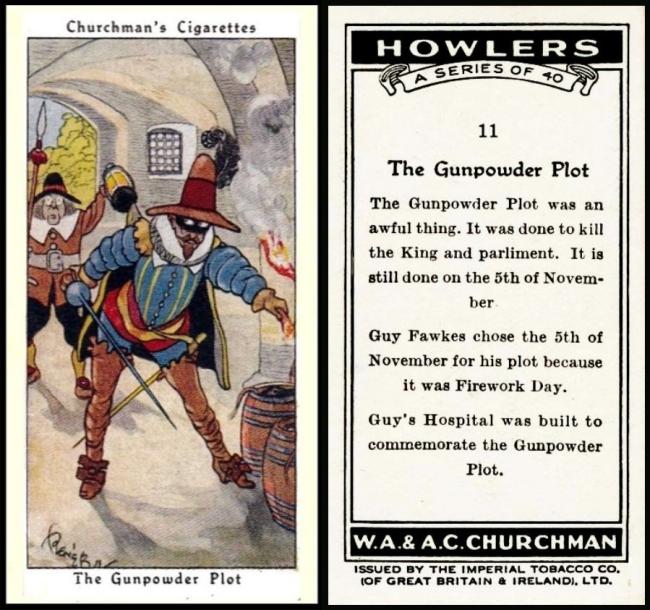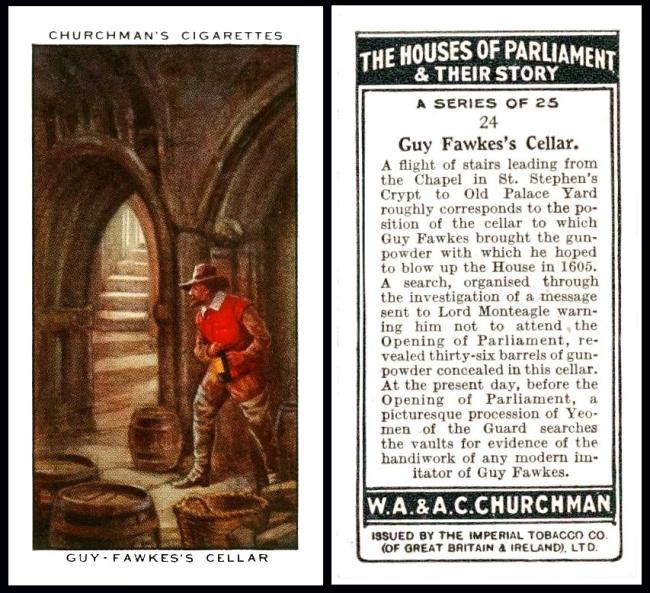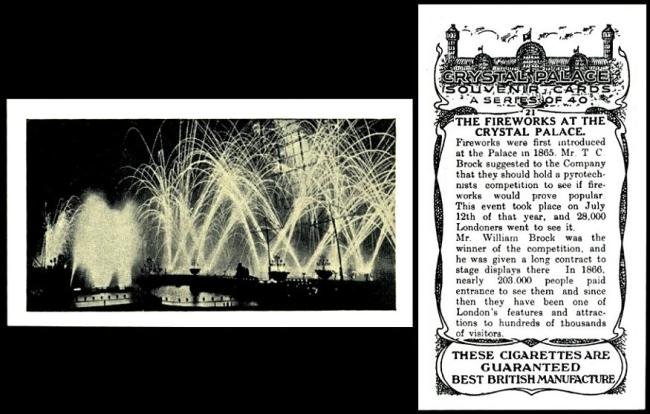With the flashes and percussions surrounding me, I sit to update another rolling research blog. And this one is dedicated to Guy Fawkes, for it is in his honour that I am so surrounded.
The strangest thing about Guy Fawkes is that his name endures, and is celebrated, even though he tried to get rid of the entire Houses of Parliament, and the King. We don`t call it the Saving of Parliament Day, or even probably remember that the plot failed. Instead we continue to send flashes and rockets up to the sky, just as he wanted to do.
Even more curious, until 1959 it was actually illegal NOT to celebrate it in Britain. Even through the two World Wars it was not banned, though the government did advise that it be celebrated indoors so as not to let the enemy see a fire burning, or a flash of a firework with which they could see where they were.
Only one place refused outright to mark the day, and its plea was allowed. This was a school, St. Peter`s in York, where Guy Fawkes had been a pupil.
They would well have appreciated this card, "Howlers" by W.A. and A.C. Churchman, issued in 1937, where errors made in schoolboy essays are immortalised for all time. Now we are not sure whether these were collected by Mr. Cecil Hunt, the Howler King of Highgate, but he does appear on the Churchman`s set "In Town Tonight", which was issued in 1938, less than a year later. Intriguing, eh?
Guy Fawkes was born some time in mid April 1570 in Stonegate, York. We do not know the actual date, as such things were not recorded, all we know is that at that time a baptism was supposed to take place before the next Sunday came around. In effect few people bothered to follow this ruling because a child of under a month old changes so little.
Guy was an unusual name, and the theory is that it was used in honour of a local nobleman, perhaps even a relative. His father was involved in the courts and in the law, and his family had a long standing connection with such; an ancestor was even Lord Mayor of York.
Hignett`s "Historical London" 14/25 tells us that he was "... the son of an advocate of York." And Carreras Ltd`s "Highwaymen" (July 1924) 14/25 tells us something else, that he was "An English gentleman, born of Protestant family at York". This is not strictly true, as Guy`s mother was a Catholic, and of a staunch Catholic family which even included a Jesuit Priest. When Guy was eight years old his father died, leaving his mother with four children. She married again, fairly soon after; the new husband was a good stepfather and also a very devout Catholic, and he had a willing audience in the children. Guy converted to Catholicism shortly after and became very interested in their beliefs.
The next piece of the story often gets confused. Some say he went off to Spain and fought for the Spanish Catholics in the Eighty Years War, but this is incorrect; the war was indeed for the Catholics, but it was against Dutch rebels, and took place in the Netherlands. Hignett`s "Historical London" (1926) 14/25 gets it right, and tells us he "served with the Spanish Army in Flanders, where he gained some military reputation."
Guy reputedly got the money to go there from selling parts of his original father`s estate. He also took relatives with him, and fought alongside the Spanish for ten years, becoming known as Guido Fawkes, and met many who were set on the idea of removing King James I from the throne of England. With this in mind, he travelled to Spain to research the theory and to seek support. This is possibly where the War and the trip became confused. During this trip, or on the way home, he met a man called Thomas Wintour, wrongly called simply "Winter" on Hignett`s "Historical London" (1926) 14/25.
Now Thomas Wintour was very important, as he provided the missing link, a man with a plan, Robert Catesby, who planned to not just remove the King but assassinate him, and already had a replacement in mind, the King`s daughter, aged just nine, young enough to do the bidding of a Regency that he would set up. This all makes me think he had friends in very high places. He was also charming and persuasive, and Guy was intrigued by him, so much so that he agreed to come aboard.
The plotters met up at the house shown on this card. There are a couple of errors on the card - the front calls it "Manor House, Ashby St. Ledger, Northants", and the back persistently calls it "Ashby St Leger", but the correct spelling is Ashby St. Ledgers.
The text tells us "The Gunpowder Plot was hatched in the Gatehouse room of the quaintly gabled Tudor Mansion of Ashby St. Leger (Northants). There were thirteen conspirators, the leader being Robert Catesby, the owner of the manor".
Another curious wording is where they say "Guy Fawkes ... was merely a paid "soldier of fortune". If that was the case it also points to him being a bit of a scapegoat.
Then there is even more intriguing wording is further down, where it says "Religious intolerance has led to endless plots and counterplots in English History, and the proposed suppression of Roman Catholic liberties by James incensed Catesby into plotting...."
The question is why it says "James" rather than the more formal "King James" - is that more than a bit of Catholic sympathy perhaps..? Or maybe anti-parliamentary ones ?
Whilst we have brought King James I into the story, he is on a card issued by Godfrey Phillips, which mentions Guy Fawkes on the reverse, but somehow manages to call him Guy "Faukes". This seems a very uncharacteristic error for such a large and prominent company to make.
Wills "Historic Events" (1913) 29/50 also seems to sympathise, for that too says, "Smarting under the severe laws passed against them in 1604, the more daring Catholics resolved to blow up James and the Parliament ... "
You may imagine that such a challenge would have taken quite a while, but the plotters soon had things in place; they even managed to rent a cellar directly below the Houses of Parliament, at a time just before the State Opening of Parliament. This is one of the things that suggests to modern researchers that the tale has hidden depths, that maybe the whole intention was to frame Guy Fawkes. However Hignett`s "Historical London" (August 1926) 14/25 suggests that this was all already planned before Thomas Wintour even met Guy Fawkes, for it says that he "brought him to England as a likely assistant in the Gunpowder Plot which was in preparation, and to him was entrusted the actual accomplishment of blowing up the parliament house".
The cellar is shown to great effect on Churchman`s "The Houses of Parliament and Their Story" (December 1931) The card is even titled "Guy Fawkes` Cellar", and it also, very thrillingly, gives its location, saying that "A flight of stairs leading from the Chapel in St. Stephens Crypt to Old Palace Yard roughly corresponds to the position of the cellar..."
The blowing up was to be done with thirty six barrels full of gunpowder, and every card so far gives this exact amount. These were smuggled in, not an easy task, and Guy Fawkes was put in direct charge. However Churchman`s "The Houses of Parliament and Their Story" (1931) 24/25 adds that "... Guy Fawkes brought the gunpowder ..", another detail which proves he must have had something to do with munitions in the Eighty Years War, as it is volatile stuff, not easy to handle, and very prone to igniting if temperatures change and it starts to sweat. You would not just entrust its care to someone who did not know it. And in addition Guy was in charge of hiding it below piles of straw and wood, which would affect those temperatures quite severely.
At this point a word. Do not think of Parliament as the modern stone structure, for at the time of this plot London had not yet had the Great Fire, and all the buildings were made primarily of wood.
Then the plan went awry. Hignett`s "Historical London" 14/25 tells us that "An anonymous letter to Lord Monteagle gave the government warning of the plot". It also reportedly told him not to attend. This letter is also mentioned on Wills "Historic Events" 29/50, where it tells us "The plot was discovered by a warning letter sent to Lord Monteagle..." Whilst Churchman`s "The Houses of Parliament and Their Story" (1931) 24/25 says "a message" rather than a letter.
After receiving that, Monteagle sent some men to investigate but they found nothing, however it still niggled at him and he showed the letter to the King. The King made haste to search the building, as it was the night before the State Opening, and when guards did this they found a man wandering the corridors in a cloak and high hat, with a lantern.
This scene kind of appears on Hignett`s "Historical London" 14/25 - entitled "Arrest of Guy Fawkes, 1605", though it shows the five guards entering the cellar with swords drawn. You can clearly see the sticks bundled together to hide the barrels, though they are visible beneath. It looks a remarkably well swept cellar. The picture is all the more impressive because it is in a monotone of brownish hue. The text tells us that "...Fawkes, a very tall and desperate fellow, was arrested in the vault beneath the parliament house, and the gunpowder discovered."
A more colourful version, and one with a great deal of action in it, appears on another card, Wills "Historic Events" 29/50 - "The Arrest of Guy Fawkes". This shows another struggle within the cellar, but the lantern can clearly be seen illuminating the scene, and one of the guards has a pistol as well as a sword. Again five guards are shown, which is rather intriguing and must have some basis in fact. The text also mentions "Thirty Six barrels" so again using fact, and continues by saying they were "laid ready beneath the House of Lords."
Wherever he was apprehended, he was searched, and found upon his person were fire lighting tools. At the same time other men found the cellar, pulled away the straw and wood and discovered the barrels.
The rest of the gang heard about this somehow, or perhaps were prepared, or maybe even one of them sent the fateful letter, and they made a dash for it. Their flight involved several running battles and some were killed. However seven were captured alive and brought down to join Guy Fawkes in jail. They were questioned, and tortured, and confessed, then charged. Their punishment was to be hung, drawn and quartered, a common and very brutal death. Hignett`s "Historical London" 14/25 tells us that "Fawkes, Winter and other conspirators were executed opposite parliament house in 1606". Whilst Wills "Historic Events" 29/50 gives a sense of a hurried and not too sympathetic trial with its closing statement "Fawkes and his accomplices were captured and executed". What it does not tell you is that when Guy Fawkes came to be hung last, he leapt in the air and broke his own neck so that he was dead before the other parts of his sentence could be carried out. Some may think this foolish; and some applaud. And so he died, rebel to the last, on the 31st of January 1606.
So you may be asking, why do we celebrate on 5 November 1605? Well that was the date that Guy Fawkes was discovered, the night before Parliament was to be destroyed.
There is a rather interesting fact to close. For on Churchman`s "The Houses of Parliament and Their Story" (1931) 24/25, it says "At the present day, before the Opening of Parliament, a picturesque procession of Yeomen of the Guard searches the vaults for any evidence of the handiwork of any modern imitator of Guy Fawkes"
So to Fireworks.
Now there are not so many of these, but we have a few.
Lets start with this pair of sparklers, both sets being known as "Conundrums" though they are not titled on the cards.
The Wills` version was issued in 1898, with the Lambert and Butler following in 1901.
For some reason the Lambert and Butler card is a slightly different size, shorter and wider.
I am most intrigued by the fact that despite there only being a three year gap between the two issues, the Lambert and Butler was able to print that "These pictures are Copyrighted and are issued exclusively with Lambert & Butler`s Cigarettes".
The fireworks here are still instantly recognisable, including the rockets. These are actually based on the first ever firecracker, developed in China in 2 B.C., which were sections of bamboo, and the name firecracker is exactly what they did, they just threw the pieces of stem on a fire and because of their sectionalised internal structure they would get hot and the air inside would explode with a loud crack.
We can also thank China for the next stage of the development of the firework, and that is gunpowder. This was invented some time between 600 and 900 A.D. And legend has it that it was almost immediately used to make those bamboo firecrackers crack all the louder. Though I am not sure how they would have squeezed it inside of the bamboo and into those empty air pockets.
Now the only other card I have so far found of fireworks is this one. The set`s title is rather concealed inside the image of Crystal Palace up at the top of the reverse, but it is "Crystal Palace Souvenir Cards". And if you look down at the bottom there is no maker, it just speaks of the cigarettes. However we know it was issued by R. & J. Hill. Now this card is quite important to the story of the firework because the text says "Fireworks were first introduced at the Palace in 1865. Mr. T. C. Brock suggested to the Company that they should hold a pyrotechnists competition to see if fireworks would prove popular." It then continues with "Mr. William Brock was the winner of the competition and he was given a long contract to stage displays there.."
These two people bring us neatly to Brock's Fireworks, which was founded in Islington way back in 1698, making it the oldest company still in existence. The founder of that was a Mr. John Brock, who died in November 1720 aged just 43. The factory seemed to move quite frequently and in 1825 their current premises were destroyed in a workplace accident involving a firework which was accidentally ignited during production. They chose not to rebuild the factory, which was entirely destroyed, they just moved on. Now some say that very shortly after this they started to hold grand night-time displays of their products for the general public, but there are records of them supplying pyrotechnics to displays as early as 1740.
In 1868 they built a new larger factory, which was under the command of C.T. Brock, and they started selling and advertising "Brock`s Crystal Palace Fireworks". So it could be that Hill got those initials the wrong way round? As for William, there are two, the first being born in 1779, but dying in 1849. However he had a son, William Edwin Brock, who was born in 1814 and died in 1869. That would make it rather a short contract to stage displays. I have been told of a website about Brocks, and that says "the competition was won by CT Brock’s father". It also supplies the names behind the initials - Charles Thomas Brock, born in 1843 and William Brock, his father, died in 1869.
Just a little cartophilic celebration









